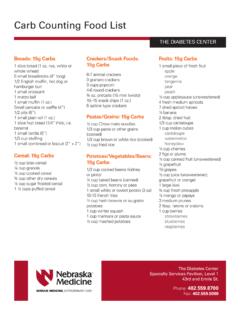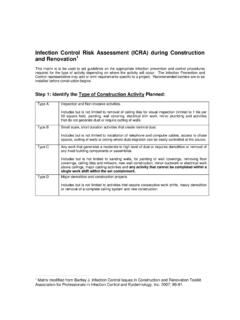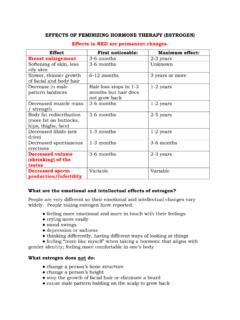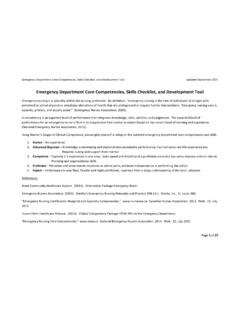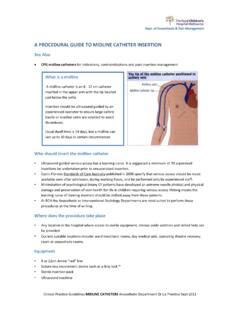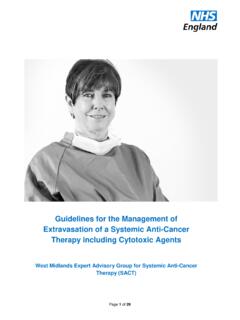Transcription of Flushing Frequencies and Use of Heparin <cont’d> Second ...
1 Flushing Frequencies and Use of Heparin <cont d>^ When administering pediatric medications the SASH technique should be used: Saline, Antibiotic/ Medication, Saline, Heparin . If dextrose is to be used in place of NS, for compatibility, pharmacy should have instructions on label(s) (4, 9).# Heparin volume should be determined by physician order (4). Consideration must be given to approximate priming volume of device and tubing configurations when determining appropriate Heparin volume to be administered (8, 9).* In an effort to avoid systemic anticoagulation of the patient during use of Heparin flushes in pediatric patients, multiple doses of Heparin over a short time period (defined here as 4 hours), that result in an average total of Heparin dosage greater than 25 units/kg/hour may constitute systemic anticoagulation.
2 All administrations of Heparin must be considered when calculating total Heparin dosage: Heparin in running IV lines, and administration through all lines and lumens of central lines being flushed (4, 9).8 Second EditionCVAD TYPE and Approximate Priming Volume (8) Heparin Use/NS Flushing Frequency for cvad in Intermittent ModeHeparin Use/NS Flushing Frequency for cvad in Maintenance ModeCentral non-tunneled closed end or valved ( , Bard Solo Power PICC) Pediatrics:approximate priming volume (8) F F - ml4 F ml5 F - ml6 F - mlAdults: Flush with 10 ml NS before and after each use or every 24 hours (or per mfr.)
3 Recommendations) (4).Pediatrics: If PICC > 2FR flush with 2-3 ml NS (or amount specified per physician order) before and after each use or every 12 hours (or per physician order) (8). After Flushing with NS, flush with Heparin (10 units/ml) after each use or every 12 hours (or per physician order) (8, 9) ^#*.Adults: Flush with 10 ml NS once weekly (or per physician order or mfr. recommendations) (3, 4).Pediatrics: If PICC > 2FR flush with 2-3 ml NS (or amount specified per physician order) every 12 hours (or per physician order) (8). After Flushing with NS, flush with Heparin (10 units/ml) every 12 hours (or per physician order) (8, 9) ^#*.
4 Non-Centrally Inserted Venous Access Device and Approximate Priming Volume (8) Heparin Use/NS Flushing Frequency for Device in Intermittent ModeHeparin Use/NS Flushing Frequency for Device in Maintenance ModeMidline catheter open or closed end, or valvedPediatrics:approximate priming volume (8)3 F ml4 F ml5 F mlAdults: If being used a minimum of every 8 hours, flush with 10 ml NS before and after each use or every 24 hours (or per mfr. recommendations) (4).Pediatrics: If Midline > 2 FR flush with 2-3 ml NS (or amount specified per physician order) before and after each use or every 12 hours (or per physician order) (4, 8).
5 After Flushing with NS, flush with Heparin (10 units/ ml) after each use or every 12 hours (or per physician order) (8, 9) ^#*.Adults: Flush with 10 ml NS every 24 hours (or per physician order or mfr. recommendations) (3, 4).Pediatrics: If Midline > 2 FR flush with 2-3 ml NS (or amount specified per physician order) every 12 hours (or per physician order) (4, 8). After Flushing with NS, flush with Heparin (10 units/ml) every 12 hours (or per physician order) (8, 9) ^#*. Flushing (SEE TABLE AT END OF GUIDELINES FOR SCHEDULE OF Flushing AND/OR USE OF Heparin ) General flushingA single use syringe should never be used more than once (even on the same lumen) (4).
6 A 10 ml syringe filled with normal saline should not be divided into several doses and used for multiple lumens (2). Syringe sizeTo prevent catheter damage, and unless otherwise directed by the manufacturer, the minimum syringe size that should be used when Flushing a cvad and for subsequent flush (post-medication administration) is 10 ml (2). Volume A minimum volume of twice the internal volume of the catheter should be used to flush the cvad (2). In general, for the adult population, 10 ml is sufficient; for the pediatric population, 1-5 ml is sufficient for the majority of catheters (4).TechniqueFlushing technique will depend upon the type of catheter and type of connector valve being used.
7 For catheters with negative pressure connector valves, the catheter should be flushed vigorously using a pulsatile motion, maintaining pressure at the end of the flush to prevent reflux back into the catheter (positive pressure technique). Positive pressure is maintained while Flushing a catheter by clamping the extension tubing while still Flushing the line (3, 6, 7). For catheters with positive pressure connector valves, the catheter should be flushed vigorously using a pulsatile motion. Disconnect syringe from injection port after Flushing and then close the clamp (6, 7). For catheters with neutral pressure connector valves, the catheter should be flushed vigorously using a pulsatile motion.
8 Clamp sequence is not required; clamping can be done before or after disconnection of syringe (6, 7).Solution and frequency for cvad in intermittent use and in maintenance NaCl (normal saline [NS]) solution should be used to flush lines before and after each use (2). (SEE TABLE AT END OF GUIDELINES FOR SCHEDULE OF Flushing AND/OR USE OF Heparin )Standardizing Central Venous Catheter Care: Hospital to Home Second EditionACCESSING A cvad AssessmentFor peripherally inserted central venous catheters and midline catheters, verify external catheter length ( , exit site markings) before accessing (2). Follow agency policy regarding accessing line if exit markings differ from information documented upon insertion (4).
9 The assessment and treatment of phlebitis, infiltration or extravsation shall be established per agency policy (2).Hand hygieneHand hygiene should be performed before and after accessing an intravascular catheter (1, 2, 3). Perform hand hygiene procedures either by washing hands with conventional soap and water or with alcohol-based hand gel (1). Glove use is required per standard precautions per Occupational Safety and Health Administration (4).Scrub time for the access capIn the absence of definitive data, we suggest scrubbing the access cap for a time of no less than 5 seconds, using 70% alcohol solution and vigorous scrubbing (1, 2, 4, 5).
10 Implanted Port Access in addition to all of the aboveUse aseptic technique and sterile gloves when accessing an implanted port (2). The RN will wear a mask when accessing an implanted port (4). Skin preparation for accessing the implanted port to be determined by agency policy (4).Cover the noncoring needle and access site of an implanted port with a transparent semipermeable membrane (TSM) dressing or gauze dressing (2). If gauze is used to support the access needle and it does not prevent visualization of the needle insertion site under a transparent dressing, it can be considered a transparent dressing and changed every 7 days (2).


